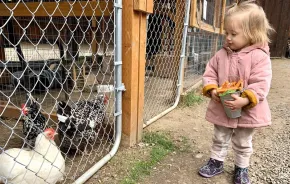
Photo:
Takuichi Fujii, watercolor on paper, 10½ × 14½ inches. Collection of Sandy and Terry Kita.
The experiences of individuals are what collectively make history. It's the role of artists among those individuals to document the experiences and preserve them for the enlightenment of future generations. Important museum exhibits on display now bring to light the history of local peoples through their art. While these exhibits are not for little kids, tweens and teens and their families can understand art as the representation of lived history.
Paintings as a record of imprisonment
"Witness to Wartime: The Painted Diary of Takuichi Fujii" is on display at the Washington State History Museum through Jan. 1, 2018. Artist Takuichi Fujii was incarcerated with members of his family during World War II, following Executive Order 9066, first in Puyallup and later at Minidoka in Idaho. The exhibit displays his wartime diary and his watercolor paintings which detail life in both camps.
This spare, two-room exhibit will feel serious to most children. My son was interested in how Fujii painted as a way to record his experiences and saddened by the scenes. For the most part, the vivid paintings speak for themselves here. If your children aren’t familiar with this period of history you will want to provide some context. And this can certainly be a teachable opportunity to discuss the lessons of history.
When I asked my sixth grader what he thought of the exhibit, his honest assessment was: “A little depressing that that happened to people.”
Indeed, perhaps that’s the main takeaway from such an exhibit — that it serves as a reminder of a dark time and a lesson for the future.
There is a digital version of the artist’s remarkable, almost 400-page diary that visitors can “page” through, but apart from that this is an art exhibit, so there are not any hands-on elements, and children should be reminded not to touch the artwork.
More at the Washington State History Museum
Mature tweens and teens may also be interested in two other temporary exhibits — both highlighting individuals' roles in history — on the same floor; one on the efforts of Northwest citizen diplomats during the Cold War and one displaying the protest photos of George P. Hickey. Join a free gallery talk with photojournalist Hickey on Thursday, Nov. 16, at 5:30 p.m.
I also recommend visiting the newly installed permanent exhibit in the great hall on the main floor, "Washington: My Home," which tells the stories of immigrants, migrants and refugees to Washington State from the 1800s to present day. This is an excellent exhibit with a diverse array of stories and objects that help tell the stories of individuals and their journeys.
My son was interested in the stories of young immigrants in particular and in seeing what possessions they chose to bring with them. Exploring this area felt like a good follow up to the Witness to Wartime Exhibit in that both encourage visitors to think about who we are as Americans, and how diverse diverse experiences shape our society.
The rest of the museum’s two main floors are also worth exploring. Younger children, in particular, will want to push the button to make the trains go, and there are many hands-on exhibits in the Great Hall that tell our state’s history. My boys always loved climbing in the covered wagon.
You’ll want to allow at least a couple hours to see it all without being rushed.
Ancient traditions live on in modern art

The White River Valley Museum in Auburn has on display a temporary exhibit called Salish Modern. This installation shows the work of globally recognized contemporary artists all of whom are from the Salish Sea area. The exhibit is on display through Dec. 17, 2017.
A plaque at the start of the exhibit explains, “Salish is a family of related languages spoken by related cultures indigenous to much of what is now western Washington and southern British Columbia. Sometimes the term “Coast Salish,” is used to refer to the tribes and First Nations whose homelands surround the… Georgia Straits, Strait of Juan de Fuca and Puget Sound (now collectively referred to as the Salish Sea).”
While we may think of totem poles when we think of native art, curator Patricia Cosgrove explained that totems aren’t part of the Coast Salish culture at all.
Cosgrove suggested that before looking at the Salish Modern exhibit, we first look at some of the traditional art from area Native American tribes in the museum’s permanent display area.
She explained that the modern artists’ work is influenced by these traditions. For example, a pattern used in basketry from thousands of years ago may show up in a modern textile, a glass sculpture or even a skateboard deck. Cosgrove also explained that Salish art was often private and associated with religious ceremonies.
It should be noted that this is a small, one-room exhibit with about a dozen or so important works. My son enjoyed it, but he was also ready to move on quickly.
Happily, the rest of the museum is also well worth the visit and many of its exhibits are thought provoking but also accessible to children.
This is a regional museum so the displays are devoted to the history of the area including the settlement of the White River Valley by early pioneers, the history of the area’s Native American tribes and the farming communities of immigrants that grew up in the valley.
One display is devoted to the life of one of the area’s Japanese families and explains what happened in World War II when they were interred and lost their homes and possessions.
There is also a section of the museum featuring recreated store fronts, a one-room school house and a train caboose. Throughout these displays there are icons indicating what children may touch, which is a helpful feature for visitors with younger kids.
The museum serves thousands of area school children on field trips, but it remains a bit of an undiscovered treasure otherwise. We were the only visitors on the rainy weekday we stopped in, and the volunteers on hand couldn’t have been friendlier or more delighted to see us.
Lost history of Chinese railroad builders
A third exhibit currently on display at Tacoma Art Museum brings to light the role of Chinese workers in building transcontinental railroads in the late 1800s. "In Search of the Lost History of Chinese Migrants and the Transcontinental Railroads" showcases the work of artist Zhi Lin and his efforts to recognize Chinese laborers' contributions to the American West. According to the exhibit information, "the absence of Chinese laborers from American history books is an animating force in Lin’s work." The temporary exhibit is on display through Feb. 18, 2018.
If you go...Hours and admission:
Tips: If you're going to downtown Tacoma museums, The Museum of Glass is always a crowd-pleaser. If you’ve brought along younger children, The Children’s Museum of Tacoma is still pay-as-you-will, and is a great place for little ones who need things they can touch and explore! There are also plentiful, kid friendly options on Pacific Avenue including The Harmon and The Old Spaghetti Factory. In Auburn, note that Les Gove Park is next to the museum and there are lots of kid-friendly dining options nearby. |











